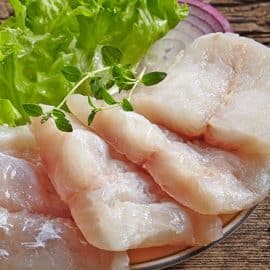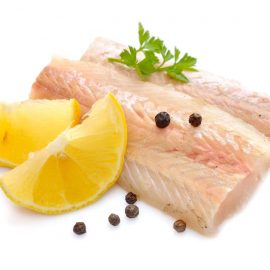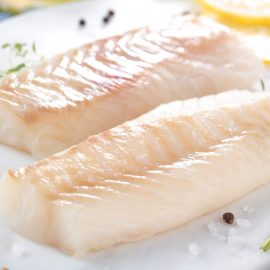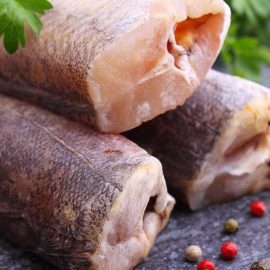
What is a Hake?
Merluccius merluccius, also known as European hake, is a slender fish closely related to cod and haddock. There are a few common characteristics among animals in taxonomic order. Haddock, cod, and hake all belong to the order Gadiformes, making them similar in both their structure and taste.
Cod and hake may be related, but their appearances aren’t exactly alike. In comparison to cod, hake has greyer skin, larger jaws, and teeth with a curved shape. There have been reports of hake growing to a length of 6 feet, but they are usually seen at a size of 2 to 3 feet.
The hake has a silvery belly and is streamlined. Hake’s flesh is delicious – it’s firm, flaky, light in colour, and a versatile fish, almost tastes like cod despite its fierce looks.
In the UK, it is seldom noticed, but in Europe, many people enjoy it. Spain is the largest consumer of hake in Europe, eating about 6 kg a year per person. From November to March, hake is primarily caught along the Southeast Atlantic and North Pacific coasts, primarily in European varieties.
Generally, hake is sold frozen or fresh, although sometimes it is smoked or salted.
Does Hake taste good?
When it comes to sustainability as well as taste, the answer is a clear yes!
UK consumers routinely eat too little hake. Hake is a healthy and tasty fish with minimal cholesterol, but it is sadly underrated.
Since we keep frozen stock all year round and can buy fresh hake year-round, you won’t have any problems buying it from us, here at Frozen Fish Direct. Hake is regarded as the king of the sea by the Spanish, which is the reason we Brits should eat it more often.
Cod or Hake: which is better?
Hake is sweeter than cod and has a more distinctive taste. Similarly to cod, hake has white skin that easily flakes off. A firm and meaty texture results when it is cooked.
If you want to get the Mediterranean flavour from your hake, add ingredients such as chorizo, sweet paprika, tomatoes, and garlic.
Cooking Hake
The Spanish call the hake the “king of fishes” because it is a white fish and quite large. The firm flesh of hake lends itself to many preparation methods, including grilling whole or searing fillets. To verify the hake flesh has been cooked, it must feel firm with an opaque colour. Fish heads and tails can be used to make flavourful fish stock – don’t throw them away.
UK consumers have been stuck with fish fingers, fish cakes, and other packaged foods long enough that they are still discovering the joys of using fresh hake in cooking. You can easily make hake a highlight with just a couple of simple steps.
Whole Hake
It is important to remove the gills and gut the hake before cooking it whole. The best way to prepare the whole hake is to roast it, but you can also barbecue it, cook hake in a foil pouch, or poach it. Wrap it in foil or cover it with a lid that fits tightly before baking. To add more flavour to roasted hake, liberally season the body and cut flesh before roasting.
Frozen Hake fillets
You can cook a hake fillet in a variety of ways. The most popular methods of preparing fish are frying it in butter and lemon juice and preparing it in a combination of fish stock, wine, and lime juice. Also, they can be roasted or steamed. Cured hake can also be cooked in a papillote with lemon and dill over a longer period.
The best way to buy Hake
The hake’s body is slim and long, and its front teeth are visible. Make sure the fish you buy are bigger than 50 cm in length and have red gills and bright eyes. There should be no colour changes, blemishes, or bruises on hake fillets.
Check the most recent sustainability reports before buying hake between February and July.
Best Hake recipes
Cover the fish in foil when baking to prevent it from dehydrating. If baking a whole fish, fill its interior with spices and lemon, or cover the fillet with them.
For barbecuing whole hake or fillets, it is recommended to marinate them one hour beforehand so the marinade penetrates as much as possible.
To give your hake a more savoury taste, try baking it with creamed leeks and bacon for a luxurious dinner.
Try baking hake flavoured with onions, garlic, and lemon.
When it comes to Hake, what goes with it?
The delicate yet sweet taste of hake is another reason for its popularity. Bacon, coconut, and horseradish are all acceptable pairings for hake.
Globally, it can be found in Indian curries, especially with cilantro, fishcakes in Thai cuisine, and fish and chips as well as other dishes.
Spanish people love hake, which they usually grill or bake with garlic, chorizo, or paprika. Roast hake and served with chickpeas, chorizo, and coriander, this dish is sure to please.
There seems to be a hake dish for every region in Spain. It is often served with clams in the Basque country, with onions, garlic, and tomatoes in Galicia, and in Catalonia, with stew potatoes.



